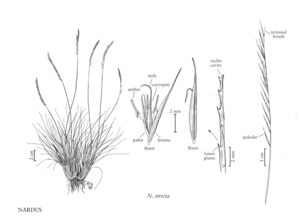Difference between revisions of "Nardus stricta"
FNA>Volume Importer |
imported>Volume Importer |
||
| (7 intermediate revisions by 2 users not shown) | |||
| Line 4: | Line 4: | ||
|publications= | |publications= | ||
|common_names=Matgrass;Narde raide | |common_names=Matgrass;Narde raide | ||
| + | |special_status={{Treatment/ID/Special_status | ||
| + | |code=I | ||
| + | |label=Introduced | ||
| + | }} | ||
|basionyms= | |basionyms= | ||
|synonyms= | |synonyms= | ||
| Line 16: | Line 20: | ||
-->{{Treatment/Body | -->{{Treatment/Body | ||
| − | |distribution=N.H.;Mass.;Mich.;Oreg.;N.Y.;Vt.;Greenland;Nfld. | + | |distribution=N.H.;Mass.;Mich.;Oreg.;N.Y.;Vt.;Greenland;Nfld. and Labr. (Labr.);N.S.;Ont.;Que.;Idaho |
|discussion=<p><i>Nardus stricta</i> is a widespread xerophytic and glycophytic species in Europe, usually growing in open areas on sandy or peaty soils. In the Flora region, it is found in scattered locations from upper Michigan to Newfoundland and Greenland, and in Oregon and Idaho, where it is listed as a state noxious weed. The stiff, sharp leaves make it unpalatable; hence it tends to survive in areas of heavy grazing. This, combined with its broad ecological range, makes its potential for spreading in western rangelands a matter of concern.</p> | |discussion=<p><i>Nardus stricta</i> is a widespread xerophytic and glycophytic species in Europe, usually growing in open areas on sandy or peaty soils. In the Flora region, it is found in scattered locations from upper Michigan to Newfoundland and Greenland, and in Oregon and Idaho, where it is listed as a state noxious weed. The stiff, sharp leaves make it unpalatable; hence it tends to survive in areas of heavy grazing. This, combined with its broad ecological range, makes its potential for spreading in western rangelands a matter of concern.</p> | ||
|tables= | |tables= | ||
| Line 26: | Line 30: | ||
-->{{#Taxon: | -->{{#Taxon: | ||
name=Nardus stricta | name=Nardus stricta | ||
| − | |||
|authority=L. | |authority=L. | ||
|rank=species | |rank=species | ||
| Line 33: | Line 36: | ||
|basionyms= | |basionyms= | ||
|family=Poaceae | |family=Poaceae | ||
| − | |distribution=N.H.;Mass.;Mich.;Oreg.;N.Y.;Vt.;Greenland;Nfld. | + | |illustrator=Linda Ann Vorobik;Hana Pazdírková |
| + | |illustration copyright=Utah State University | ||
| + | |distribution=N.H.;Mass.;Mich.;Oreg.;N.Y.;Vt.;Greenland;Nfld. and Labr. (Labr.);N.S.;Ont.;Que.;Idaho | ||
|reference=None | |reference=None | ||
|publication title= | |publication title= | ||
|publication year= | |publication year= | ||
| − | |special status= | + | |special status=Introduced |
| − | |source xml=https:// | + | |source xml=https://bitbucket.org/aafc-mbb/fna-data-curation/src/200273ad09963decb8fc72550212de541d86569d/coarse_grained_fna_xml/V24/V24_70.xml |
|subfamily=Poaceae subfam. Pooideae | |subfamily=Poaceae subfam. Pooideae | ||
|tribe=Poaceae tribe Nardeae | |tribe=Poaceae tribe Nardeae | ||
Latest revision as of 17:24, 11 May 2021
Culms (3)10-40(60) cm, stiff, wiry, frequently gray-green; nodes 1(2) per culm, restricted to the lower portion of the culms, pubescent; internodes glabrous. Sheaths smooth, whitish, tough; ligules 0.5-1(2) mm, blunt; blades 4-30 cm long, 0.5-1 mm wide, stiff, tightly convolute, abaxial surfaces hispid, hairs about 0.3 mm, adaxial surfaces scabridulous, ribbed over the veins, apices sharply acute. Spikes (1)3-8 cm, terminating in a single bristle, bristle to 1 cm. Spikelets 5-10 mm, narrowly linear, triangular in cross section, bluish or purplish; lemmas 5-10 mm, 2-3-keeled, awned, awns 1-4.5 mm; paleas slightly shorter than the lemmas; anthers 1-4 mm. Caryopses 3-4.5 mm, tighdy enclosed by the lemma and palea. 2n = 26.
Distribution
N.H., Mass., Mich., Oreg., N.Y., Vt., Greenland, Nfld. and Labr. (Labr.), N.S., Ont., Que., Idaho
Discussion
Nardus stricta is a widespread xerophytic and glycophytic species in Europe, usually growing in open areas on sandy or peaty soils. In the Flora region, it is found in scattered locations from upper Michigan to Newfoundland and Greenland, and in Oregon and Idaho, where it is listed as a state noxious weed. The stiff, sharp leaves make it unpalatable; hence it tends to survive in areas of heavy grazing. This, combined with its broad ecological range, makes its potential for spreading in western rangelands a matter of concern.
Selected References
None.
